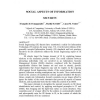Free Online Productivity Tools
i2Speak
i2Symbol
i2OCR
iTex2Img
iWeb2Print
iWeb2Shot
i2Type
iPdf2Split
iPdf2Merge
i2Bopomofo
i2Arabic
i2Style
i2Image
i2PDF
iLatex2Rtf
Sci2ools
ISSA
2008
2008
Social Aspects of Information Security
Social Engineering (SE) threats have constituted a reality for Information Technology (IT) systems for many years. Yet, even the latest editions of the generally accepted Information Security (IS) standards and best practices directives do not effectively address the Social Engineering aspect of IS defences. SE attacks target the human element of IS by exploiting human relations to the maximum possible extent. The social relations between interacting individuals who are involved in an Information Security Management System (ISMS) structure, combined with the frequently unpredictable fashion that humans act and react to stimuli, provide opportunities that Social Engineers may and do exploit. In the ongoing effort against Social Engineering attacks, if the social elements of IS are ignored, fallacious working assumptions may be made. These inadvertently result in the creation of insufficient controls against identified SE threats. Hence, simply put, Information Security scientists can n...
Related Content
| Added | 29 Oct 2010 |
| Updated | 29 Oct 2010 |
| Type | Conference |
| Year | 2008 |
| Where | ISSA |
| Authors | Evangelos Frangopoulos, Mariki M. Eloff, Lucas M. Venter |
Comments (0)

